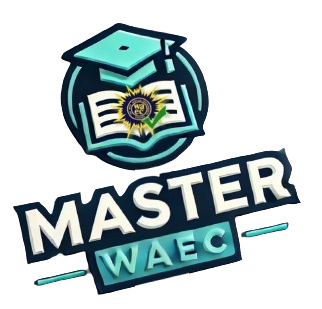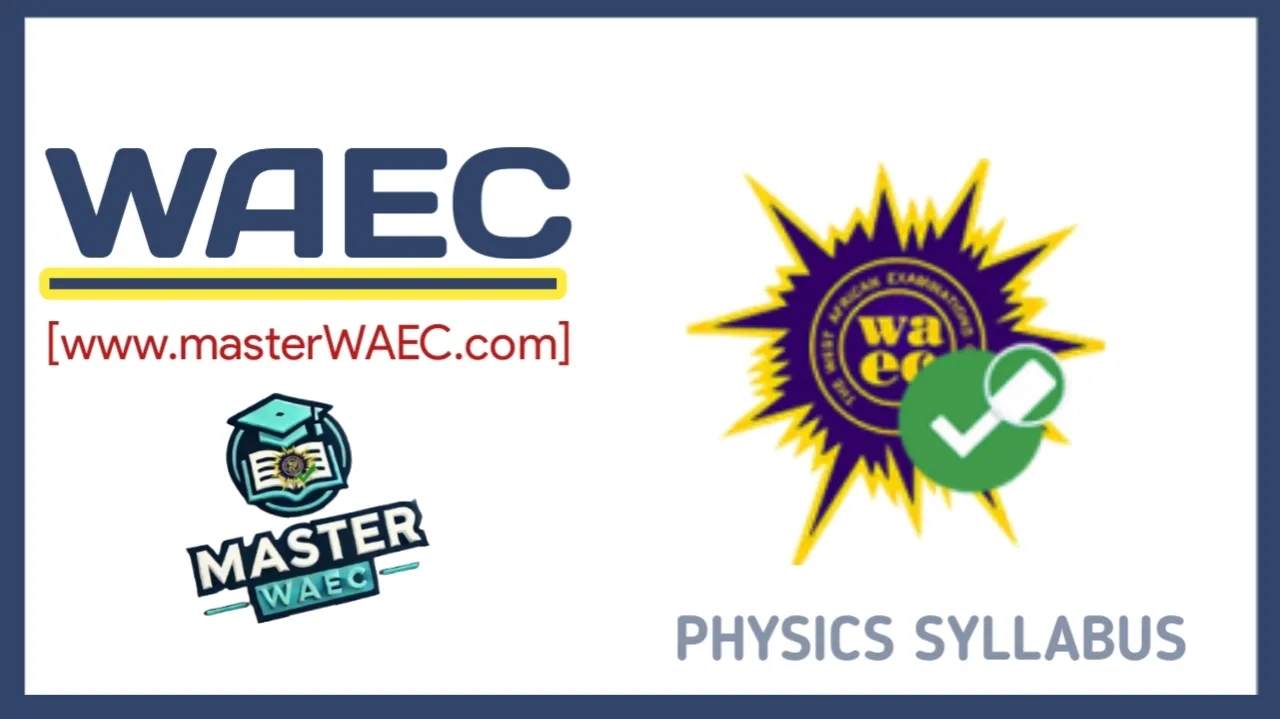WAEC Syllabus for Physics 2025: The WAEC Physics syllabus is an outline of the course structure for the West African Senior School Certificate Examination in Physics.
This syllabus, therefore, covers the main topics in mechanics, heat energy, waves, electricity, magnetism, and modern physics, ensuring that candidates are introduced to the fundamental principles in these areas, with acquisition of skills in problem solving.
In this guide, we are going to break down the syllabus, discuss the structure of the exam, and provide tips on how one can prepare for the Physics exam in 2025.
Key Objectives of the WAEC Syllabus for Physics 2025
The WAEC Physics syllabus aims to:
- Equip students with a solid understanding of Physics principles and their applications.
- Develop scientific skills such as precision, accuracy, and problem solving.
- Highlight the importance and limitations of scientific methods in real life contexts.
- Instill positive attitudes such as integrity, curiosity, and inventiveness in learners.
WAEC Physics Exam Structure
The Physics exam consists of three papers:
Paper 1: Objective Questions
- Format: 50 Objective questions.
- Duration: 1 hour 15 minutes.
- Marks: 50 marks.
Paper 2: Theory Questions
- Section A: 7 structured questions (answer 5).
- Section B: 5 essay questions (answer 3).
- Duration: 1 hour 30 minutes.
- Marks: 60 marks.
Paper 3: Practical (or Alternative to Practical for Private Candidates)
- Format: 3 questions (answer 2).
- Duration: 2 hours 45 minutes.
- Marks: 50 marks.
Key Topics in the WAEC Syllabus for Physics 2025
1. Mechanics
- Concept of Matter: States of matter (solid, liquid, gas), Brownian motion, and kinetic theory.
- Motion and Force: Types of motion (rectilinear, rotational), Newton’s laws, equilibrium, and friction.
- Work, Energy, and Power: Types of energy (kinetic, potential), conservation laws, and efficiency of machines.
- Momentum: Elastic collisions, conservation of momentum, and impulse.
- Gravitation: Newton’s law of gravitation, gravitational potential, and escape velocity.
2. Heat Energy
- Temperature and Expansion: Thermometers, thermal expansion, and applications (e.g., bimetallic strips).
- Heat Transfer: Conduction, convection, and radiation. Practical examples include sea breezes and vacuum flasks.
- Gas Laws: Boyle’s law, Charles’ law, and the general gas equation.
- Latent Heat: Specific latent heat of fusion and vaporization, and their applications in refrigerators and pressure cookers.
3. Waves
- Wave Types and Properties: Transverse and longitudinal waves, amplitude, wavelength, and frequency.
- Light Waves: Reflection, refraction, total internal reflection, and applications like periscopes and lenses.
- Sound Waves: Speed of sound, echoes, resonance, and musical instruments.
- Electromagnetic Waves: Radio waves, infrared, visible light, X-rays, and gamma rays.
4. Electricity and Magnetism
- Electrostatics: Coulomb’s law, electric field, potential, and capacitors.
- Current Electricity: Ohm’s law, series and parallel circuits, electrical energy, and power.
- Magnetic Fields: Properties of magnets, magnetic force, and applications like electric motors and generators.
- Electromagnetic Induction: Faraday’s and Lenz’s laws, transformers, and power transmission.
5. Modern Physics
- Atomic Structure: Models of the atom, energy levels, and spectra.
- Photoelectric Effect: Dual nature of light, Einstein’s equation, and applications in T.V. and cameras.
- Radioactivity: Radioactive decay, half life, and applications in medicine and agriculture.
- Nuclear Energy: Fission, fusion, and safety precautions in nuclear energy use.
WAEC Syllabus for Physics 2025
Part 1: Interaction of Matter, Space, and Time
- Concepts of Matter
- Fundamental and Derived Quantities and Units
- Position, Distance, and Displacement
- Mass and Weight
- Time
- Fluids at Rest
- Motion
- Speed and Velocity
- Rectilinear Acceleration
- Scalars and Vectors
- Equilibrium of Forces
- Simple Harmonic Motion
- Newton’s Laws of Motion
Part 2: Energy – Mechanical and Heat
- Forms of Energy
- Work, Energy, and Power
- Heat Energy
- Temperature and Measurement
- Thermal Expansion
- Heat Transfer (Conduction, Convection, Radiation)
- Gas Laws
- Measurement of Heat Energy
- Latent Heat
- Evaporation and Boiling
- Vapour and Vapour Pressure
- Humidity and Weather
Part 3: Waves
- Production and Propagation of Waves
- Types of Waves
- Properties of Waves (Reflection, Refraction, Diffraction, Interference, etc.)
- Light Waves
- Sources of Light
- Rectilinear Propagation
- Reflection and Refraction
- Application of Lenses
- Dispersion of Light
- Electromagnetic Waves
- Sound Waves
- Sources, Transmission, and Characteristics
- Echoes and Reverberation
- Vibration in Strings and Pipes
Part 4: Fields
- Description and Properties of Fields
- Gravitational Field
- Electric Field
- Electrostatics
- Current Electricity
- Magnetic Field
- Electromagnetic Field
- Electromagnetic Induction
Part 5: Atomic and Nuclear Physics
- Structure of the Atom
- Photoelectric Effect
- Thermionic Emission
- X-Rays
- Structure of the Nucleus
- Radioactivity
- Nuclear Reactions (Fission and Fusion)
- Wave-Particle Paradox
Harmonized Topics (For All Member Countries)
- Derived Quantities and Dimensional Analysis
- Projectile Motion
- Satellites and Rockets
- Elastic Properties of Solids
- Thermal Conductivity (Solar Energy and Blackbody Radiation)
- Fibre Optics
- Introduction to LASER
- Magnetic Materials
- Electrical Conduction Through Materials (Electronics)
- Structure of Matter
- Wave-Particle Paradox
WAEC Syllabus for Physics 2025 PDF Download
Tips for Success in WAEC Physics 2025
1. Master the Basics: Understand fundamental concepts and definitions, such as Newton’s laws, heat transfer, and wave properties.
2. Practice Calculations: Solve problems involving equations of motion, Ohm’s law, and specific heat capacity.
3. Leverage Practical Knowledge: Get hands-on experience with apparatus like the pendulum, calorimeter, and lenses.
4. Use the Syllabus: Focus your studies on the topics outlined in the WAEC syllabus.
5. Work on Past Questions: Familiarize yourself with WAEC exam format by practicing physics past papers.
RELATED POST:
WAEC WhatsApp Group 2025 – Join Us Now
WAEC Registration 2025: Fees, Starting Date And Deadline
WAEC GCE First Series 2025 Registration Form, Fee And Date
Conclusion
The WAEC syllabus for physics 2025 clearly outlines how to excel in the subject. Systematic studying, regular practice, and focusing on both theory and practical aspects will give students the maximum possibility of success.
For further guidance, refer to the syllabus or seek advice from your teachers about topics that may be causing problems. Good luck in your preparations!

Kolade Kayode, known as Mr. KK, I am a Nigerian education blogger and founder of MasterWAEC.com. Passionate about student success, I simplifies WAEC exam preparation with accurate tips and resources to help students excel.


I really appreciate sir/Ma
May Almighty Allah crown our efforts